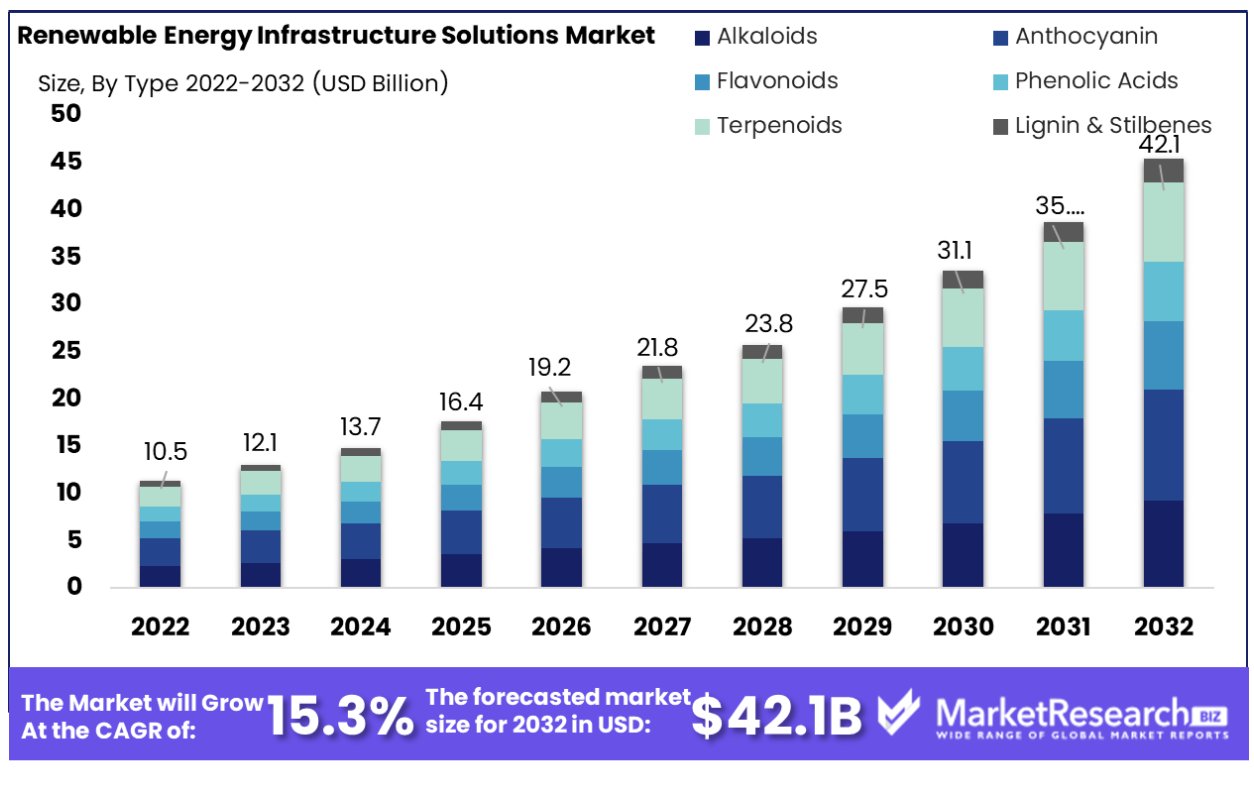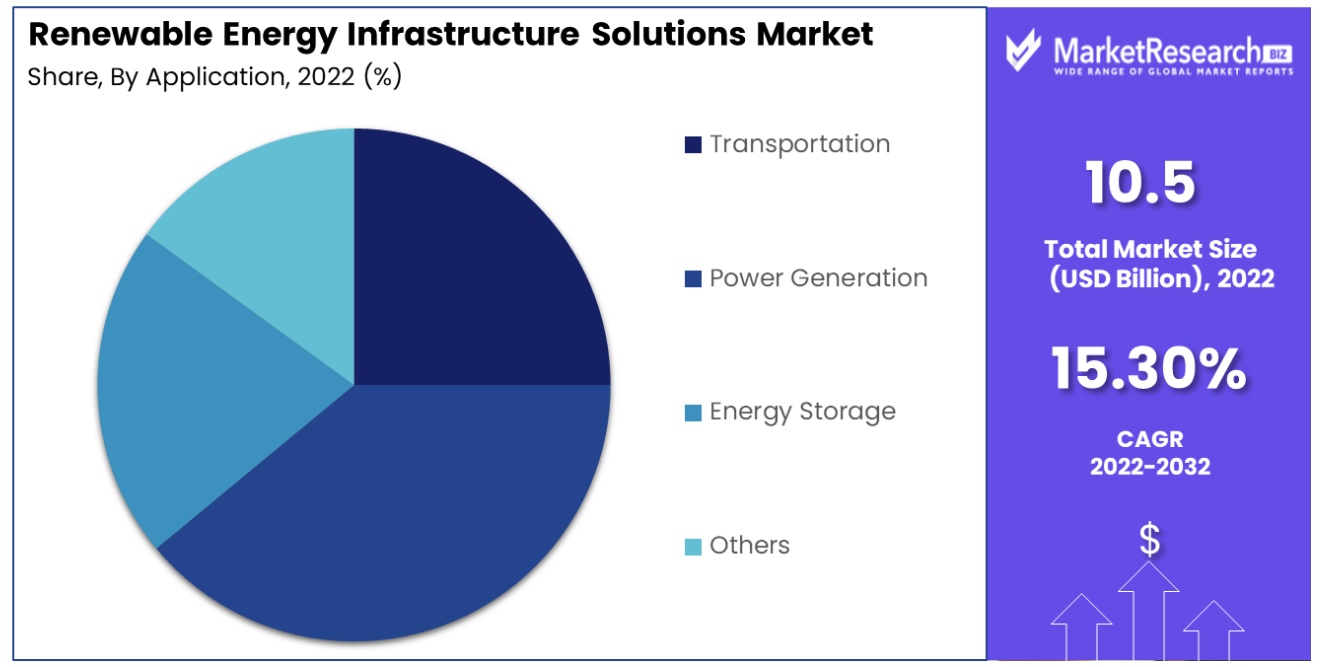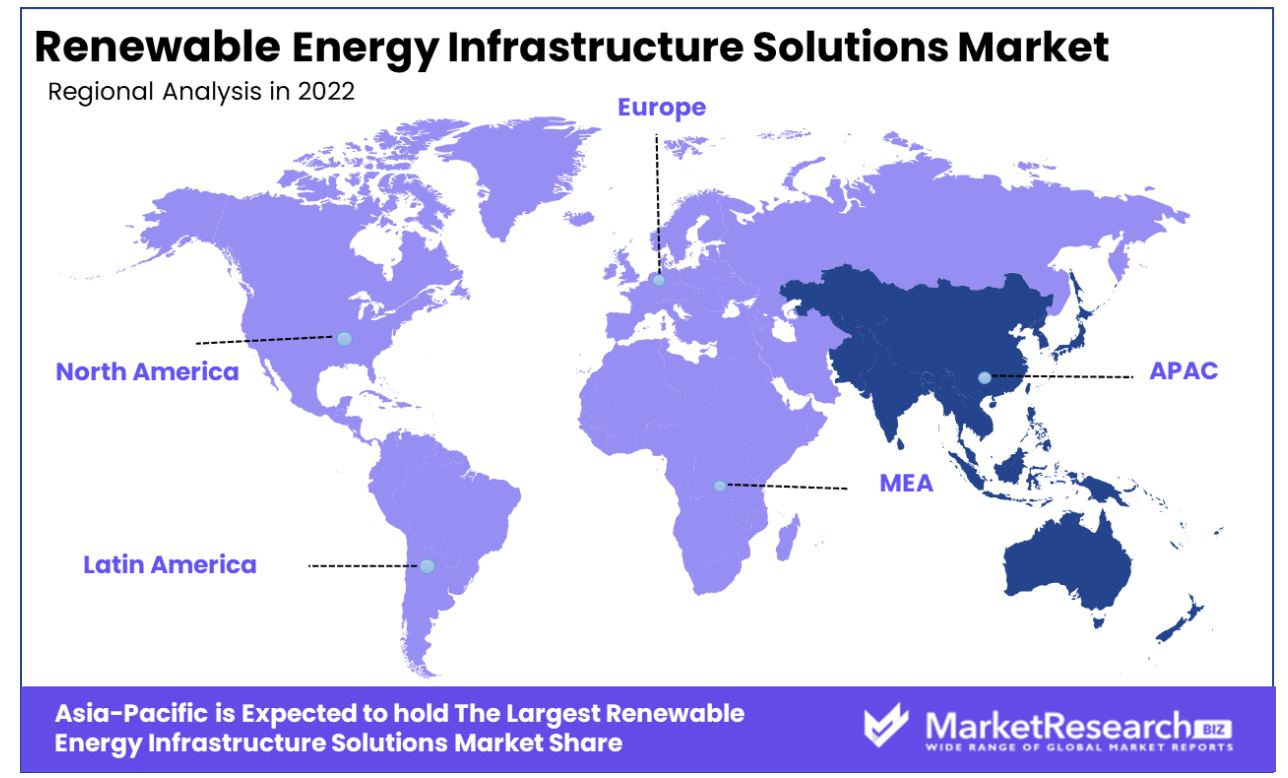
Renewable Energy Infrastructure Solutions Market By Product Type(PV Inverters, Wind Power Converters, Energy Storage Systems, EV Charger, Energy IoT Devices, High Power Motor Drives, Others), BY Application(Power Generation, Transportation, Energy Storage, Others), By Region And Companies - Industry Segment Outlook, Market Assessment, Competition Scenario, Trends, And Forecast 2024-2033
-
42864
-
Feb 2022
-
176
-
-
This report was compiled by Shreyas Rokade Shreyas Rokade is a seasoned Research Analyst with CMFE, bringing extensive expertise in market research and consulting, with a strong background in Chemical Engineering. Correspondence Team Lead-CMFE Linkedin | Detailed Market research Methodology Our methodology involves a mix of primary research, including interviews with leading mental health experts, and secondary research from reputable medical journals and databases. View Detailed Methodology Page
-
Quick Navigation
- Driving Factors
- Restraining Factors
- Renewable Energy Infrastructure Solutions Market Segmentation Analysis
- Market Industry Segments
- Renewable Energy Infrastructure Solutions Market Regional Analysis
- Market Industry By Region
- Renewable Energy Infrastructure Solutions Market Key Player Analysis
- Market Industry Key Players
- Market Recent Development
- Report Scope
The Renewable Energy Infrastructure Solutions Market was valued at USD 10.5 Billion in 2022. It is expected to reach USD 42.1 billion by 2032, with a CAGR of 15.30% during the forecast period from 2023 to 2032.

Renewable Energy Infrastructure Solutions include the design, construction, and operation of systems that generate power using renewable sources such as solar farms, wind turbines, hydroelectric dams, and geothermal plants - these solutions are vital in creating a more sustainable energy future. They involve integrating renewable sources into existing grids while providing reliable energy distribution; meeting storage, transmission, and output challenges with ease - all while being cost-effective and scalable at creating long-term infrastructure for renewables. Renewable energy requires significant investments in transmission infrastructure, including upgraded lines, substations, and smart grid technologies. This is crucial to manage the influx of utility-scale renewable sources and ensure reliable delivery to load centers. Bloomberg released a report showing that global investments in renewable energy reached a record $358 billion during the first half of 2023, an impressive 22% rise over the same period last year. Solar power dominated these investments with two-thirds being dedicated solely towards solar PV installations.
Companies involved with design, construction, and infrastructure upgrades represent an incredible growth opportunity by supporting renewable energy transition investments that not only expand renewable sources but also drive innovation and job creation within infrastructure sectors.
There is also a growing interest in microgrids, especially in areas with less reliable grid infrastructure, which opens up opportunities for companies specializing in their design and installation. Microgrids, featuring on-site renewables and storage, offer resilience and local power control, making them increasingly attractive. Their modular and scalable nature suits a variety of contexts, from remote communities to urban settings, indicating a robust market potential. This trend is driven by the need for energy independence and the growing preference for decentralized energy solutions.
Integrating energy storage systems with wind and solar farms is a burgeoning market opportunity. The value for companies lies in their expertise in creating systems that optimize storage technology, which is essential for balancing intermittent renewable energy sources. Proprietary system optimization algorithms are a key competitive advantage, enhancing efficiency and maximizing returns on renewable investments.
Financing solutions for residential solar installations play a pivotal role in driving distributed, small-scale solar energy installations forward. In the US alone, over 85% of residential PV systems are financed, through options such as loans, leases, and power purchase agreements.
Innovative financing models and vendor partnerships can significantly boost market volume, making solar more accessible to a broader consumer base. This trend is furthered by consumer interest in sustainable energy as well as government incentives encouraging its adoption. Companies providing flexible yet affordable financing solutions are well suited to take advantage of this expanding market, facilitating the widespread adoption of residential solar solutions.
Driving Factors
Technology Advancements Boost Commercial Renewable Energy Demand
Estimates provided by the International Energy Agency for 2022 indicate that renewable energy supplies from solar, wind, hydroelectricity, geothermal heat pumps, and ocean sources increased by nearly 8% to account for 12.5% of total global energy production. Technological innovations may open an additional 80% wind potential within this decade according to research performed at the National Renewable Energy Laboratory; solar sources with such cost-effectiveness now compete directly against their traditional counterparts.
This cost reduction has spurred increased adoption across the commercial sector, where businesses are seeking sustainable and economically viable energy alternatives. The trend towards more advanced and affordable renewable technologies indicates a continued expansion of the market, driven by a combination of economic and environmental factors.
Climate Concerns and ESG Factors Attract Investments
Growing concerns related to climate change and environmental, social, and governance (ESG) factors are spurring investments in renewable energy sources. With an awareness of traditional sources' negative environmental impact increasing rapidly, renewables offer a viable solution to address such concerns.
Investments driven by ESG factors are not just ethical decisions but also strategic business moves, as companies and investors recognize the long-term viability and necessity of sustainable energy solutions. This trend is expected to continue, underpinning market growth as renewable energy becomes integral to meeting global environmental and social goals.
Global Energy Crisis Accelerates Renewable Energy Installations
As countries face energy shortages and high fossil fuel prices, there is a renewed urgency to diversify energy sources and increase energy security through renewables.
This situation provides significant opportunities for growth in the renewable energy infrastructure market, as governments and industries seek rapid solutions. However, it also presents challenges, such as the need for rapid scaling of infrastructure and technology. The ongoing energy crisis is likely to continue influencing the market, emphasizing the importance of renewable energy in global energy strategies.
Demand Surge and Legislative Initiatives Propel Market Growth
Renewable energy infrastructure solutions market growth is driven by multiple factors: rising renewable energy demand, surged electricity consumption, legislative initiatives, and financial initiatives are major catalysts. Population growth and industrialization necessitate an expansion of energy infrastructure with renewables increasingly seen as the solution to meeting this growing global need for electricity in an eco-friendly manner. Legislative and financial initiatives, such as subsidies, tax incentives, and regulatory support, are crucial in facilitating this expansion. This combination of increasing demand, consumption, and supportive policies suggests robust and sustained market growth, driven by the need to develop renewable energy infrastructure to meet current and future energy needs.
Restraining Factors
Insufficient Transmission Capacity and Grid Constraints Hinder Renewable Energy Deployment
Renewable capacity additions globally are projected to reach an unprecedented 107 gigawatts (GW), totaling over 440 GW by 2023. Solar will likely account for 67% of this increase and new solar additions could break another record by then. As renewable energy generation increases, existing electrical grids can struggle to accommodate new sources due to capacity limitations and outdated infrastructure; This problem is especially acute for large-scale renewable projects like wind and solar farms that are located far from consumption centers, such as wind and solar farms. An inadequate transmission infrastructure limits the effective utilization of renewable resources thereby slowing market development.
Supply Chain Disruptions Affect Renewable Energy Market Growth
Renewable energy markets have also been negatively impacted by supply chain disruptions, leading to delays and higher costs associated with infrastructure development. Such disruptions may stem from geopolitical tensions, trade disputes, or global events like pandemics. Renewable energy systems often rely on components that are in short supply due to supply constraints, such as solar panels or wind turbine parts. leading to critical shortages that increase production costs significantly. Delays in project timelines due to these supply chain challenges further hinder market expansion. As a result, the pace of new renewable energy installations can slow down, affecting the overall growth of the renewable energy infrastructure solutions market.
Renewable Energy Infrastructure Solutions Market Segmentation Analysis
By Product Type
In the renewable energy infrastructure solutions market, PV Inverters emerge as the dominant segment, holding a 28.2% market share. This prominence is attributed to the pivotal role PV inverters play in solar energy systems, converting the direct current (DC) produced by solar panels into alternating current (AC) suitable for grid use and home applications. The surging global adoption of solar energy, driven by declining costs and favorable government policies, has significantly boosted the demand for efficient and reliable PV inverters. Technological advancements in these inverters, such as improved conversion efficiency, grid support capabilities, and integration with energy storage systems, further enhance their market appeal.
Other key products in this market include Wind Power Converters, which are essential for translating wind turbine energy into usable electricity; Energy Storage Systems, crucial for balancing the intermittency of renewable sources; EV Chargers, supporting the rising electric vehicle trend; Energy IoT Devices, providing enhanced monitoring and management capabilities; High Power Motor Drives, used in various industrial applications to improve energy efficiency; and other innovative components that support the infrastructure of renewable energy systems.
By Application
The Power Generation segment, commanding a 54.4% share, stands as the most significant application in the renewable energy infrastructure solutions market. This segment's dominance can be seen through its global transition towards renewable energy sources like solar, wind, and hydro for sustainable electricity production. This growth is furthered by global initiatives aiming at reducing carbon emissions; technological advancements which increase installation efficiencies; as well as an ever-increasing need for clean energy worldwide. Energy Storage plays a pivotal role in controlling the variability and increasing the reliability of renewable energy sources. The 'Others' category encompasses diverse applications such as residential and commercial heating, cooling, and off-grid renewable energy solutions, each contributing to the broader adoption and integration of renewable energy in various aspects of daily life.

Market Industry Segments
By Product Type
- PV Inverters
- Wind Power Converters
- Energy Storage Systems
- EV Charger
- Energy IoT Devices
- High Power Motor Drives
- Others
BY Application
- Power Generation
- Transportation
- Energy Storage
- Others
Renewable Energy Infrastructure Solutions Market Regional Analysis
Asia Pacific Dominates with 46% Market Share in Renewable Energy Infrastructure Solutions
Asia Pacific’s significant 46% share in the renewable energy infrastructure solutions market, valued at USD 4.3 billion, is driven by the region's aggressive push towards renewable energy adoption. Countries like China, India, and Japan are leading this shift, heavily investing in solar, wind, and hydroelectric power infrastructure. The region's vast natural resources for renewable energy, coupled with governmental support through incentives and favorable policies, contribute to this market dominance.

The market dynamics in Asia Pacific are influenced by the region's commitment to reducing carbon emissions and mitigating climate change. The growing awareness of environmental sustainability among businesses and the general public further boosts the market. Technological advancements in renewable energy generation, storage, and distribution enhance the efficiency and viability of renewable infrastructure. Furthermore, public-private partnerships and international collaborations in renewable energy projects foster a conducive environment for market growth.
Europe's Leading in Sustainability and Technological Innovation
The European Union's ambitious renewable energy targets and sound policy frameworks support the development and implementation of renewable energy projects. Their targets range from 20% renewables by 2020 rising to 32% by 2030 - wind and solar power overtook gas electricity generation for the first time in 2022, reaching nearly 40% across Europe.
North America's Growing Investment in Renewable Energy
The region's emphasis on reducing greenhouse gas emissions and the growing demand for clean energy drive the market. North America’s technological capabilities and supportive policy environment are significant factors contributing to the development of renewable energy infrastructure solutions. The region's focus on innovation and efficiency in renewable energy projects supports its growing market presence.
Market Industry By Region
North America
- The US
- Canada
Europe
- Germany
- France
- The UK
- Spain
- Italy
- Russia
- Netherlands
- Rest of Europe
Asia-Pacific
- China
- Japan
- South Korea
- India
- New Zealand
- Singapore
- Thailand
- Vietnam
- Rest of Asia Pacific
Latin America
- Brazil
- Mexico
- Rest of Latin America
Middle East & Africa
- South Africa
- Saudi Arabia
- UAE
- Rest of the Middle East & Africa
Renewable Energy Infrastructure Solutions Market Key Player Analysis
Delta Electronics, Inc., with its expertise in power and thermal management solutions, leads the market in providing efficient and reliable infrastructure for renewable energy systems, emphasizing the industry's focus on innovation and technological advancement.
Panduit Corp and HARTING Technology Group, known for their electrical and network infrastructure solutions, play crucial roles in the deployment and integration of renewable energy systems, reflecting the market's shift towards interconnected and smart energy networks. Duke Energy Sustainable Solutions and Ameresco, specializing in sustainable energy projects, contribute significantly by offering end-to-end solutions for renewable energy development, from planning to implementation.
Collectively, these companies drive the Renewable Energy Infrastructure Solutions Market's growth, representing diverse strategies from technological innovation to comprehensive project management, crucial for the development and integration of efficient and sustainable renewable energy systems globally.
Market Industry Key Players
- Delta Electronics, Inc
- Panduit Corp
- Duke Energy Sustainable Solutions
- Delta Electronics
- Ameresco
- Enel X S.r.l.
- HARTING Technology Group
- Ramboll
- VENA ENERGY
- Siemens
- Toyota
Market Recent Development
- In April 2021, Walmart revealed that it has achieved the deployment of 6.5 MW of solar power systems in its seven stores in California, which was developed by Sol Customer Solutions. Moreover, the portfolio consisted of a mixture of solar power systems deployed in parking lot rooftops and carports that costsaboutUS$10 million, and Bank of America (BOA) was the tax-equity partner.
- In April 2020, Engie entered into a partnership with Eocycle-XANT to include wind turbines in its product portfolio in Belgium. Engie is supposed to acquire customer requests and requirements and forward them to Eocycle-XANT which will look after the installation and maintenance of the wind turbines offered to the customer.
Report Scope
Report Features Description Market Value (2023) USD 10.5 Billion Forecast Revenue (2033) USD 42.1 Billion CAGR (2024-2032) 15.30% Base Year for Estimation 2023 Historic Period 2016-2023 Forecast Period 2024-2033 Report Coverage Revenue Forecast, Market Dynamics, COVID-19 Impact, Competitive Landscape, Recent Developments Segments Covered By Product Type(PV Inverters, Wind Power Converters, Energy Storage Systems, EV Charger, Energy IoT Devices, High Power Motor Drives, Others), BY Application(Power Generation, Transportation, Energy Storage, Others) Regional Analysis North America - The US, Canada, Rest of North America, Europe - Germany, France, The UK, Spain, Italy, Russia, Netherlands, Rest of Europe, Asia-Pacific - China, Japan, South Korea, India, New Zealand, Singapore, Thailand, Vietnam, Rest of Asia Pacific, Latin America - Brazil, Mexico, Rest of Latin America, Middle East & Africa - South Africa, Saudi Arabia, UAE, Rest of Middle East & Africa Competitive Landscape Delta Electronics, Inc, Panduit Corp, Duke Energy Sustainable Solutions, Delta Electronics, Ameresco, Enel X S.r.l., HARTING Technology Group, Ramboll, VENA ENERGY, Siemens, Toyota Customization Scope Customization for segments, region/country-level will be provided. Moreover, additional customization can be done based on the requirements. Purchase Options We have three licenses to opt for Single User License, Multi-User License (Up to 5 Users), Corporate Use License (Unlimited User and Printable PDF) -
-
- Delta Electronics, Inc
- Panduit Corp
- Duke Energy Sustainable Solutions
- Delta Electronics
- Ameresco
- Enel X S.r.l.
- HARTING Technology Group
- Ramboll
- VENA ENERGY
- Siemens
- Toyota




